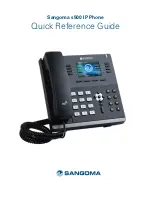
Appendix
345
Step
Action
Description
F1
INVITE—User A to Proxy
Server
User A sends the INVITE message to a
proxy server. The INVITE request is an
invitation to User B to participate in a
call session.
In the INVITE request:
The IP address of User B is inserted
in the Request-URI field.
User A is identified as the call
session initiator in the From field.
A unique numeric identifier is
assigned to the call and is inserted
in the Call-ID field.
The transaction number within a
single call leg is identified in the
CSeq field.
The media capability User A is
ready to receive is specified.
The port on which User B is
prepared to receive the RTP data is
specified.
F2
INVITE—Proxy Server to User
B
The proxy server maps the SIP URI in the
To field to User B. Proxy server forwards
the INVITE message to User B.
F3
100 Trying—User B to Proxy
Server
User B sends a SIP 100 Trying response
to the proxy server. The 100 Trying
response indicates that the INVITE
request has been received by User B.
F4
100 Trying—Proxy Server to
User A
The proxy server forwards the SIP 100
Trying to User A to indicate that the
INVITE request has already been
received.
F5
486 Busy Here—User B to
Proxy Server
User B sends a SIP 486 Busy Here
response to the proxy server. The 486
Busy Here response is a client error
response indicating that User B is
successfully connected but User B is
busy on the IP phone and unable or
unwilling to take the call.
Summary of Contents for SIP-T38G
Page 1: ...T 3 x G A d mi n i s t r a t o r G u i d e...
Page 2: ......
Page 5: ......
Page 13: ......
Page 45: ...Administrator s Guide for SIP T3xG IP Phones 32...
Page 195: ...Administrator s Guide for SIP T3xG IP Phones 182...
Page 207: ...Administrator s Guide for SIP T3xG IP Phones 194...
Page 399: ...Administrator s Guide for SIP T3xG IP Phones 386...
















































